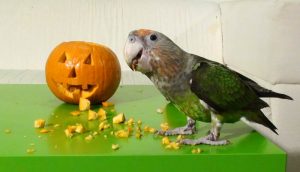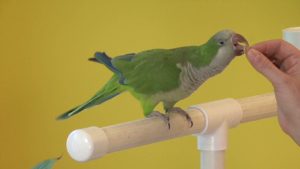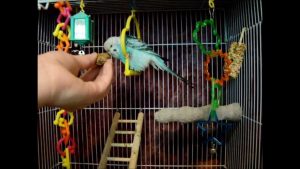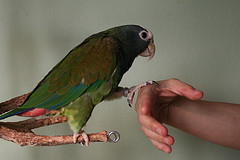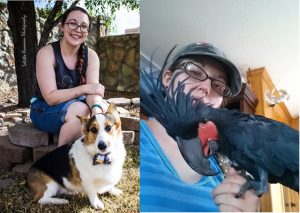The saying “bird brained” has sometimes been used as an insult. The truth of the matter is that birds of all kinds have complicated brains and are incredibly intelligent. Due to this intelligence, birds (especially parrots) will need to stay mentally active. Providing a variety of toys and rearranging perches and swings will help keep your bird mentally stimulated. However, just using these items by themselves may not be enough for your birds. Training them new tricks and continuing to practice these tricks will keep your birds thinking as well as a providing chances to bond with you more. Let’s learn some tips for training and a few simple tricks to begin with.
Training Tips
When you’re first starting to teach your companion bird, make sure they are already somewhat comfortable with your presence. Some tricks may require you holding the bird while others can be expanded upon to achieve physical contact. Setting the pace for training is up to the bird. Positive reinforcement is the best way for the bird to progress. Because of their intelligence, birds will remember the reward they receive consistently when preforming the trick, however, they will also remember punishment or any negative reinforcement.
The best item to help with positive reinforcement is the use of treats. Treats are an excellent way to show that your bird is performing the correct activity. Training treats are a bit different from regular, everyday treats. A training treat is a treat that is highly desired by the bird but is also not so filling that they will become full during the training session. It is a special, favorite treat that they do not get often. Some possible training treats include a bite of sprayed millet, seeds, nuts, bird pellets, fruits, and vegetables. You can remove the bird’s food from the cage for a maximum of three hours before training sessions so that your bird is a bit hungry and will have a greater response to treats. Also, you can offer different treats throughout the training session. Start out with a treat that the bird enjoys and as training session continues, offer one that is more desired and finally towards the end, offer their favorite treat. For example, let’s say you are training your cockatoo: you first offer it a sunflower seed after each correct action in training, as the bird progresses maybe offer out a pellet treat that it enjoys. Finally, when your cockatoo has done such a good job in training for the day, give it a bite of fresh banana for each correct action until you are ready to end training.
It is always important to stay patient with training. In this same thought pattern it is also helpful to keep training sessions short. When the bird starts to act out or lose interest, it is best to end training for the time. You can do a few training sessions a day with break times in between. Training should take place in a safe area without places for the bird to fly off and potentially get injured and training should also take place in a neutral space. Neutral spaces are areas that is not designated as “the birds” space or areas that can be defined as “your” space. Often a bathroom works well as a neutral space. Bathrooms typically have minimum things hanging from the ceiling, is a space that neither you nor the bird spend great quantity of time in, and is an easily-controlled small space. However, for some tricks it might be easier to begin in the birds cages versus the neutral space. It all depends on the type of trick you are teaching and if it’s one that will be used while your bird is in the cage.
When training, it is important to take small steps. Remember that when you’re just starting to train your bird, you will not have the trick mastered by the end of the session. Keep working on it for several training sessions and continue to revisit the trick often so you and the bird do not forget it. It is always important to end all training sessions positive note. Ending positively helps you and your bird wrap up and feel accomplished even if you do not feel like much progress has been made. When you end on a bad note, you and your bird will feel frustrated and it is likely you will also both feel this way when you’re starting the next session. Ending in a good, positive way will make both of you feel successful and start the next session fresh and renewed.
Step Up
The trick of “step up” is a great one to start a birds training with and can become a use full everyday trick to know. The goal of “step up” is to have the bird step onto a surface such as a perch or a hand where you can then transport the bird somewhere else calmly and safely. This is a great trick for when your bird becomes more use too human contact and is an easy way to place them in and out of the cage. This is a trick that you can begin to train your bird inside its cage and is a good trick to begin with a shyer bird.
1) To begin “step up”, you can start with your hand open inside their cage, holding some treats while your bird is on a perch. Your goal is to have the bird feel comfortable eating out of your hand or even standing on your hand. The treat is both a lure and a reward at this point, and you should praise your bird for accomplishing each step in training.
2) Next, you are going to hold the treat in one hand and have the other hand either holding a perch for the bird to “step up” on, or have your hand with one or two fingers pointed so they can “step up” onto it. Hold the item that you want the bird to “step up” on in front of the bird on the perch but at a higher level than the current perch, just below the bird’s chest level. Hold the treat behind the “step up” item to help entice the bird onto it. When the bird puts a foot or completely moves onto the “step up” item, say the command “step up” while in fluxing your voice higher on the word “up”.
3) Once your bird is comfortable on the “step up” item, slowly move that item over and behind their original perch so that it becomes the new step up item. Situate the bird so that the new “step up” item is a bit higher then where your bird is currently standing, about the bird’s chest level. Say “step up” with the same voice flux as before and lure the bird onto this perch with a treat.
4) Finally, when your bird is more comfortable with the step up command, you may remove it from its cage using this command and practice this trick more. Using both hands as a continuous ladder makes a fun and easy way to practice this command.
Stay tuned for Part II coming out soon!
Ashley Gurnea, our Avian Editor, is a certified bird feeding specialist at Wild Birds Unlimited. A graduate from New Mexico State University, Ashley earned her bachelor degree in the field of Animal Science. She completed an internship at an exotic animal park, working with animals ranging from camels to porcupines and a variety of birds such as parrots and cockatoos. This love and curiosity of aviary has led her to her current position at Wild Birds Unlimited in Las Cruces where she remains up to date with local wild feeder birds. Growing up in a home where animals have always been present, Ashley is now a self-proclaimed “Corgi Countess” due to her love and adoration for her tricolor Pembroke welsh corgi, Colin. Bring up anything corgi or bird related in a conversation and Ashley will be happy to share her many photos. Feel free to ask her about pet birds, and visit Wild Birds Unlimited for questions on wild birds! Ashley can be reached at ashleygurnea@gmail.com.

